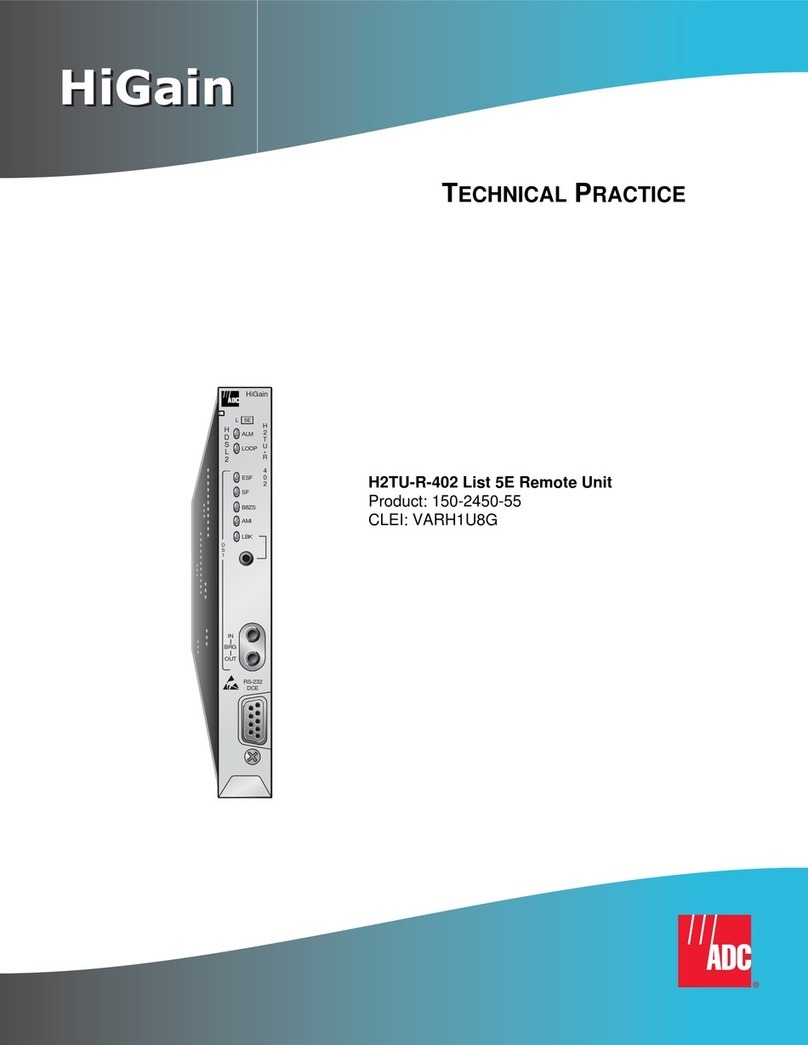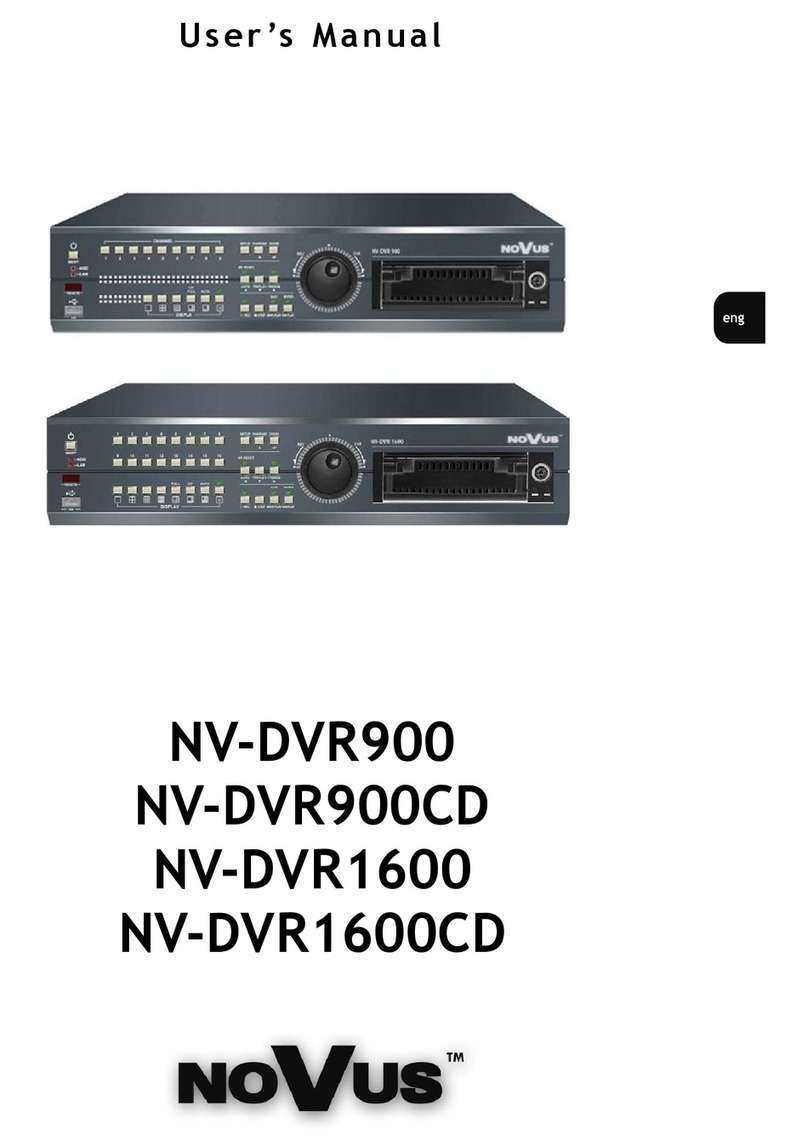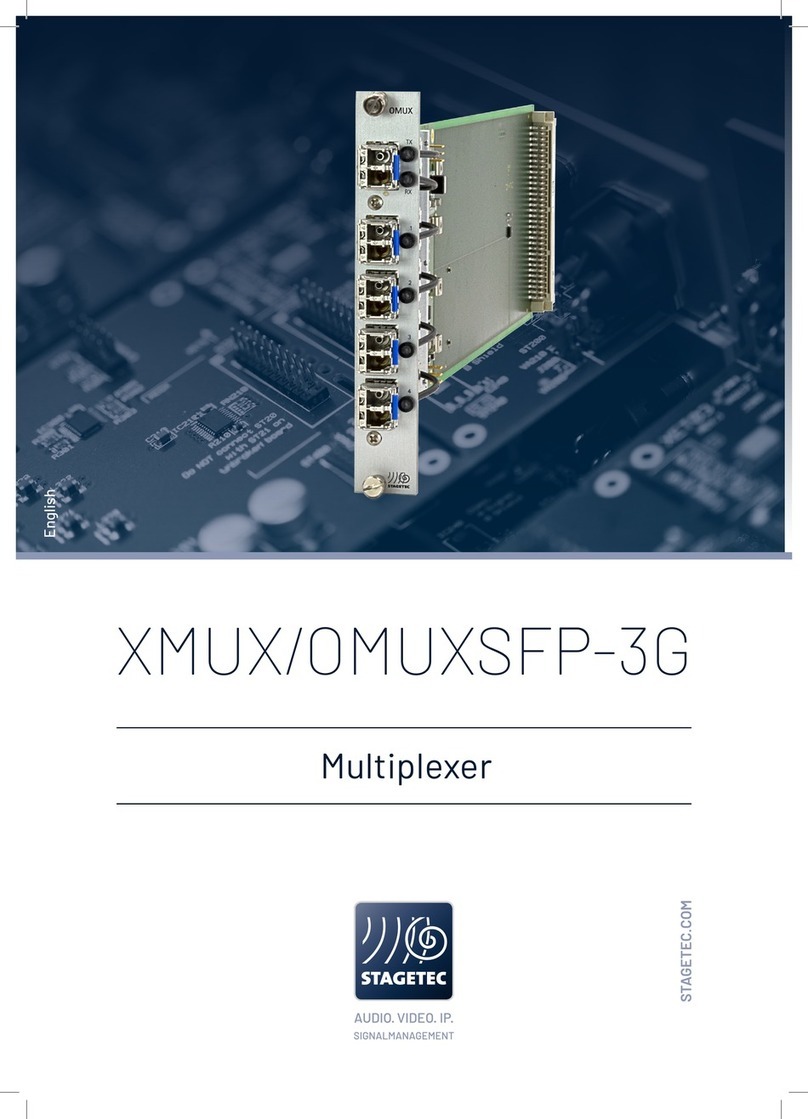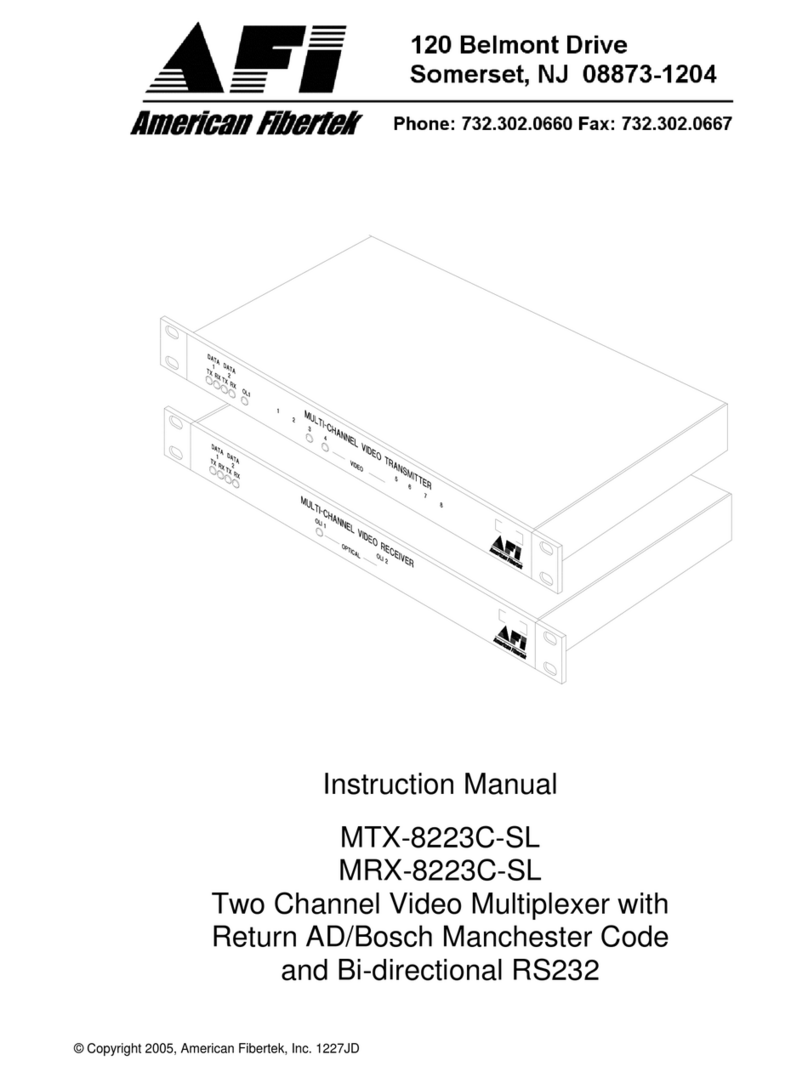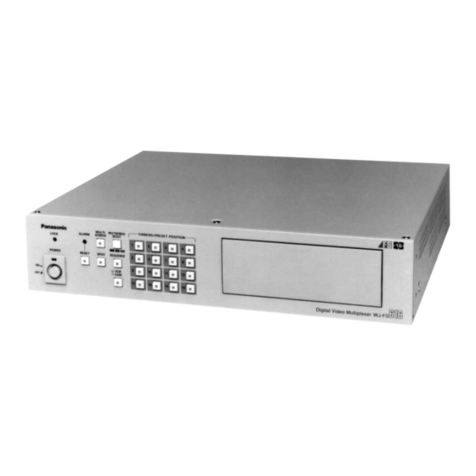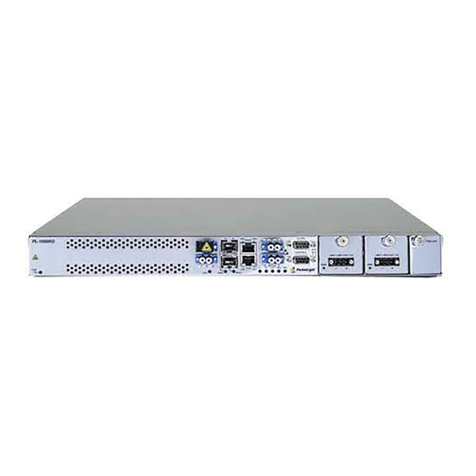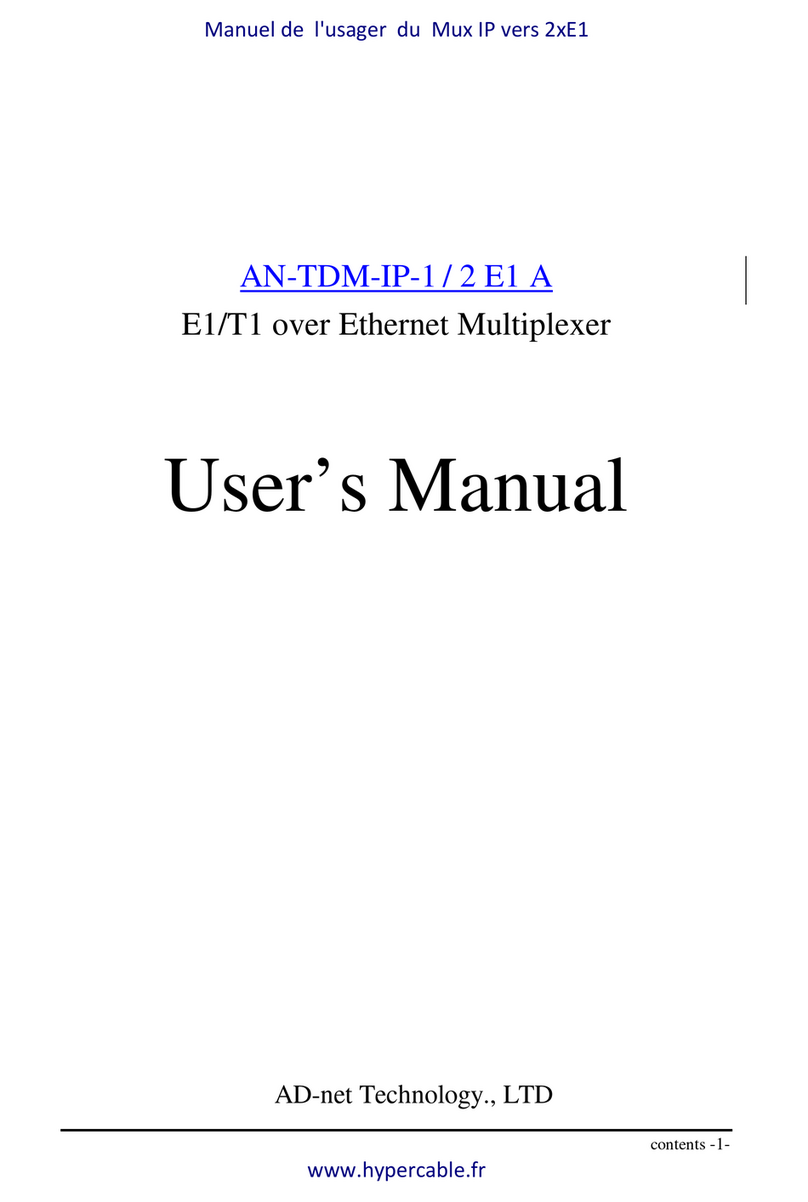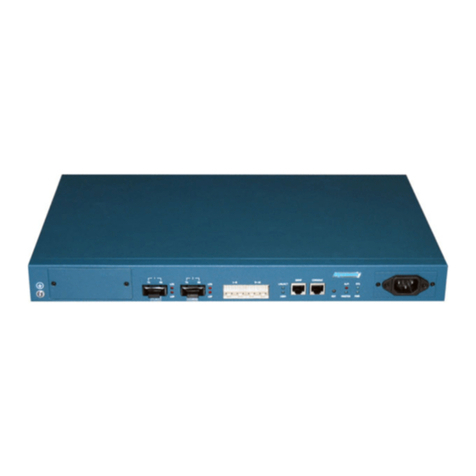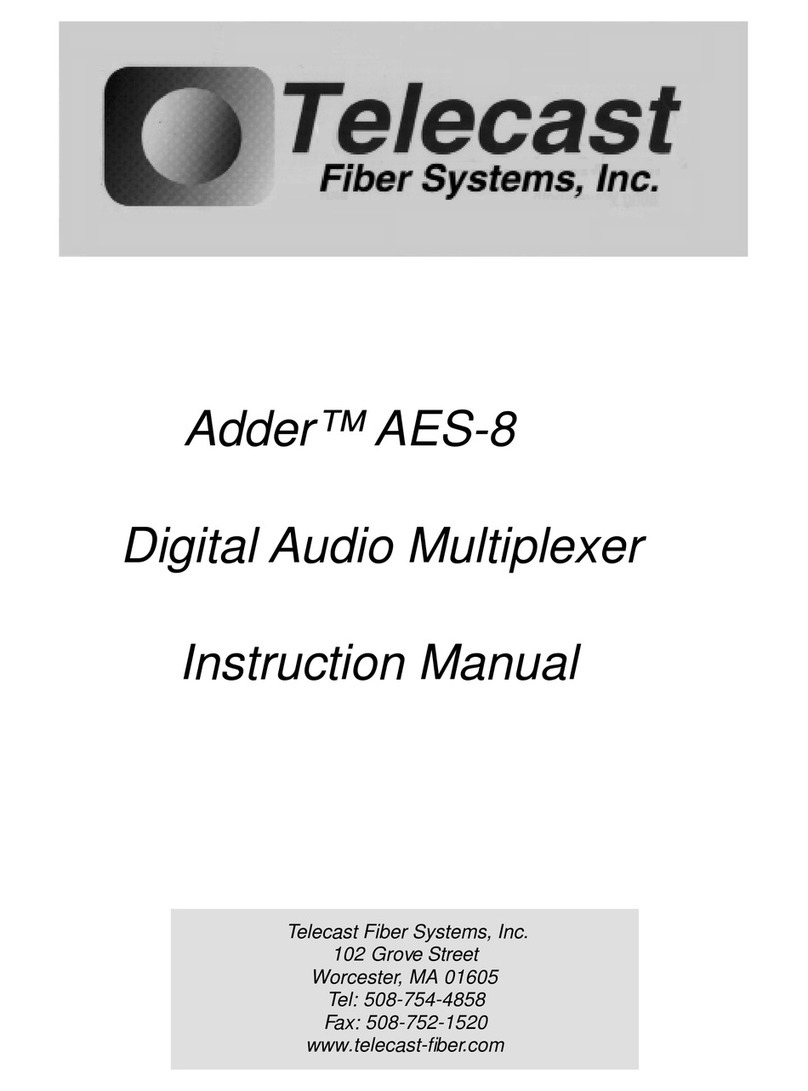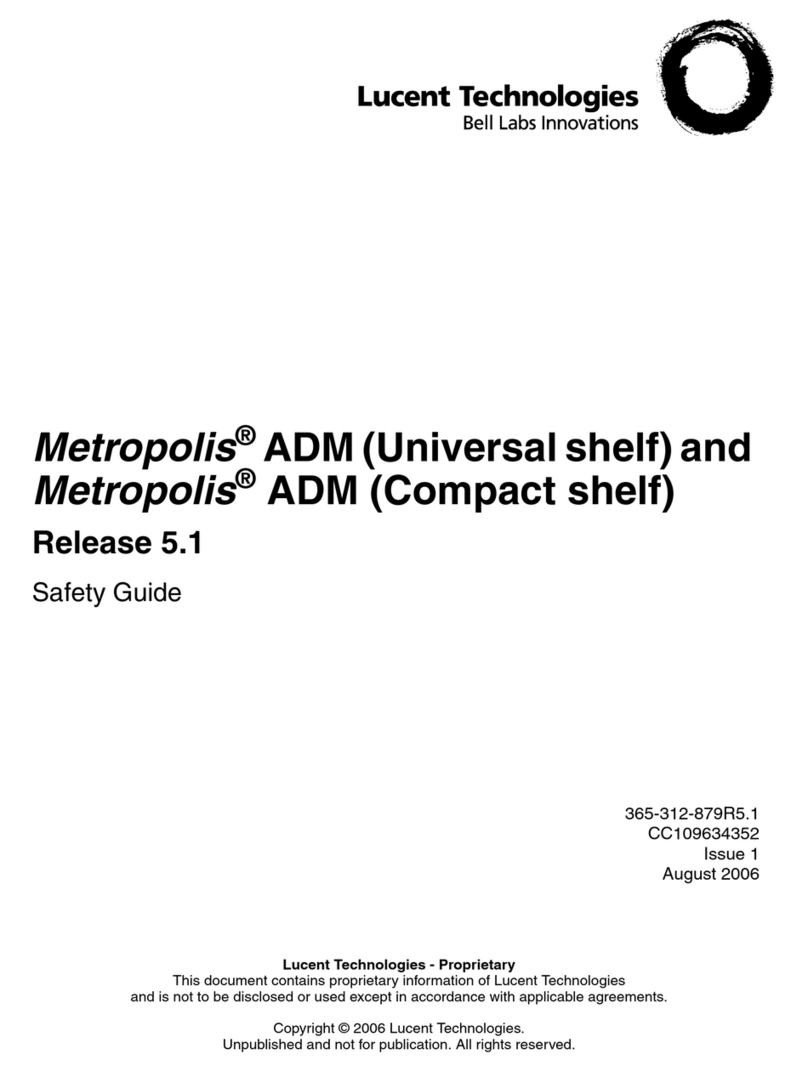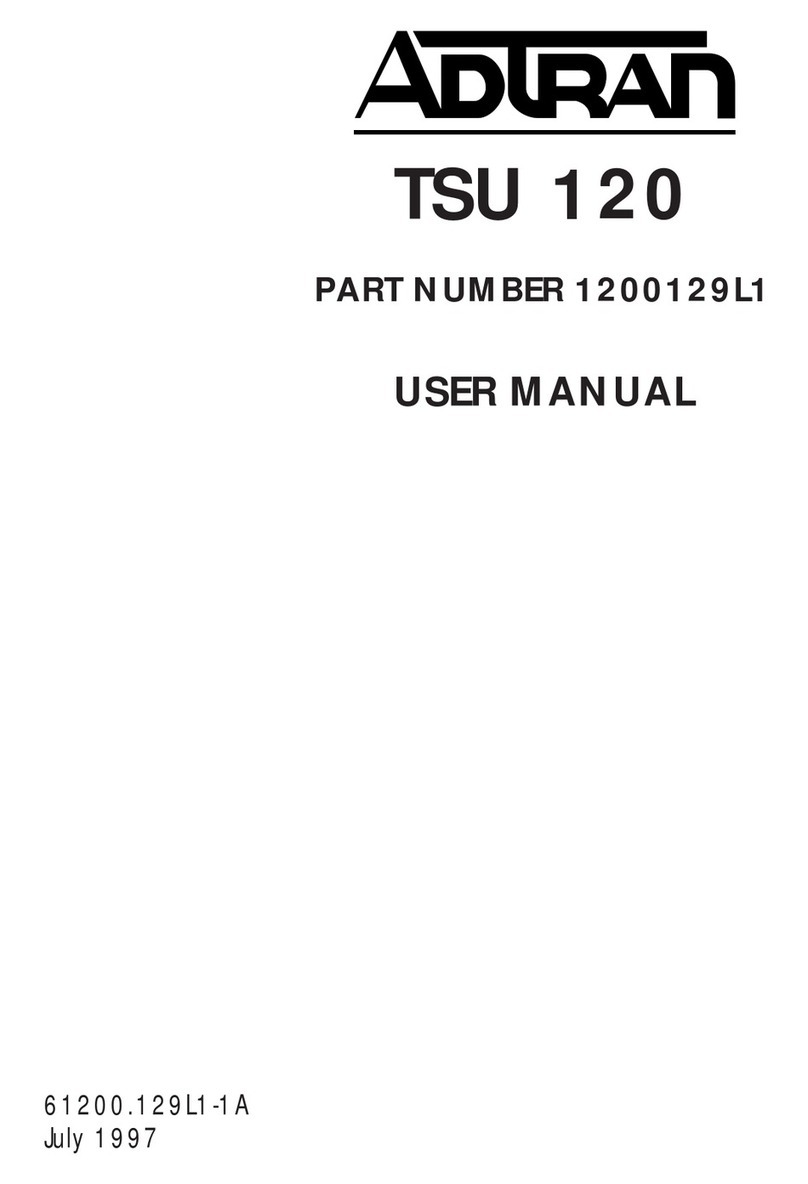BayTech Telplex TX102 User manual

OWNER'S MANUAL
TELPLEX MODELS TX102,
TX104 AND TX108
STATISTICAL MULTIPLEXERS
Revision 1.04 and 3.03
BayTech Publication #U140E069-05

Thank you for selecting aTelplex statistical multiplexer.
The data provided in this Owner's Manual explains the various ways you
can operate your Telplexand configure it to your own computer system.
We suggest that you read this manual carefully before attempting to
install the Telplex and that you place special emphasis on correct cabling
and configuration. If you have any problems with your installation, please
contact a BayTech applications engineer for assistance at 1-800-523-
2702.
BayTech also manufactures data communications devices that provide
port sharing and expansion, port contention, buffered or non-buffered
printer sharing, network print servers, and data acquisition multiplexing.
If you would like information on any of these models, please contact
BayTech customer service.
We welcome any comments you may have about our products. And we
hope that you will continue to look to BayTech for your data
communications needs.

NOTE: The information contained in this document is subject to
change without notice.
Copyright 1994 by Bay Technical Associates, Inc.
Telplex, LaserShare, Print Master and TRAN-X are registered
trademarks of Bay Technical Associates, Inc.
IBM, IBM PC, IBM PC/AT, IBM PC/XT are products and registered
trademarks of International Business Machines Corporation.
Hewlett-Packard LaserJet is a product and registered trademark of the
Hewlett-Packard Company.
All products or company names are trademarks of their respective
holders.

TABLE OF CONTENTS
1GENERAL INFORMATION................................................................................................... 1
2SPECIFICATIONS.............................................................................................................. 5
3INSTALLATION .................................................................................................................. 9
3.1 UNPACKING..................................................................................................... 9
3.2 SOFTWARE UTILITY DISKETTE .......................................................................... 9
3.3 POWER ........................................................................................................... 10
3.4 FACTORY DEFAULT CONFIGURATION.............................................................. 11
3.5 COMPOSITE PORT CABLING............................................................................. 12
3.5.1 MODEM CONNECTION...................................................................... 12
3.5.1.1 TX104/TX108 MODEM CONNECTION ................................... 12
3.5.1.2 TX102 MODEM CONNECTION ............................................ 14
3.5.2 CABLE CONNECTION ....................................................................... 15
3.5.2.1 TX104/TX108 CABLE CONNECTION .................................... 15
3.5.2.2 TX102 CABLE CONNECTION.............................................. 16
3.6 TERMINAL PORT CABLING................................................................................ 17
3.6.1 TX104/TX108 TERMINAL PORT CONNECTION...................................... 17
3.6.2 TX102 TERMINAL PORT CONNECTION ............................................... 19
4OPERATION ..................................................................................................................... 20
4.1 TERMINAL PORT OPERATION ........................................................................... 20
4.1.1 GENERAL ........................................................................................ 20
4.1.2 USER-PROGRAMMABLE OPERATIONS............................................... 20
4.1.2.1 SERIAL PORT CONFIGURATION ....................................... 20
4.1.2.2 DATA BLOCK SIZE............................................................ 21
4.1.2.3 LOCAL ACCESS ............................................................... 21
4.1.2.4 STATUS MESSAGES.......................................................... 21
4.1.2.5 SERIAL PORT DESTINATION ............................................. 23
4.1.2.6 UNIT NUMBER ................................................................. 23
4.2 COMPOSITE OPERATION .................................................................................. 24
4.2.1 GENERAL ........................................................................................ 24
4.2.2 USER-PROGRAMMABLE OPERATIONS............................................... 24
4.2.2.1 BAUD RATE ..................................................................... 24
4.2.2.2 LINE TYPE....................................................................... 24
4.2.2.3 PROGRAMMABLE STRINGS............................................... 25

4.3 OPERATING MODES......................................................................................... 26
4.3.1 SYSTEM/LOCAL MODE...................................................................... 26
4.3.2 LOCAL UNIT AND REMOTE UNIT CONFIGURATION MODE.................. 28
4.3.3 MUX MODE....................................................................................... 29
4.3.4 DIAGNOSTICS MODE........................................................................ 30
4.3.4.1 DIAGNOSTICS MODE FOR MULTI-DROP UNITS.................. 30
4.3.4.2 DIAGNOSTICS MODE FOR STANDARD UNITS.................... 33
4.3.5 ACCESS MODEM COMMAND MODE................................................... 35
4.3.6 OPERATION MODE AT POWER-UP.................................................... 35
4.4 LED INDICATORS............................................................................................. 36
4.4.1 MULTI-DROP UNITS - LED DESCRIPTION .......................................... 36
4.4.2 STANDARD UNITS - LED DESCRIPTION ............................................ 37
4.5 SELECT SWITCH.............................................................................................. 38
4.6 DATA FLOW CONTROL..................................................................................... 39
4.6.1 HARDWARE HANDSHAKING............................................................. 40
4.6.1.1 CTS OUTPUT FLOW CONTROL.......................................... 40
4.6.1.2 DTR INPUT FLOW CONTROL ............................................ 40
4.6.1.3 RTS/DSR PASS THROUGH................................................ 41
4.6.2 XON/XOFF FLOW CONTROL.............................................................. 41
4.6.2.1 XON/XOFF OUTPUT FLOW CONTROL RECEIVE DATA
DIRECTION (RECV).......................................................... 41
4.6.2.2 XON/XOFF INPUT FLOW CONTROL TRANSMIT DATA
DIRECTION (XMIT) ............................................................ 42
5CONFIGURATION PROCEDURE........................................................................................ 42
5.1 MAIN CONFIGURATION MENU.......................................................................... 44
5.1.1 MULTI-DROP UNIT MAIN CONFIGURATION MENU.............................. 44
5.1.2 STANDARD UNIT MAIN CONFIGURATION MENU................................ 45
5.2 STATUS........................................................................................................... 46
5.3 SERIAL PORT CONFIGURATION ....................................................................... 47
5.4 BLOCK SIZE, PORT LOCAL ACCESS AND STATUS MESSAGES............................ 51
5.5 PROGRAMMABLE STRINGS............................................................................... 54
5.6 SET SERIAL PORT DESTINATION ...................................................................... 57
5.7 SET THIS UNIT NUMBER................................................................................... 58
5.8 COMPOSITE PORT CONFIGURATION ................................................................ 59
5.9 EXIT................................................................................................................. 61

6APPLICATION EXAMPLES................................................................................................. 61
6.1 "POINT-TO-POINT" APPLICATION ....................................................................... 61
6.2 "STAR" APPLICATION........................................................................................ 63
7MAINTENANCE................................................................................................................. 65
7.1 RETURNS TO THE FACTORY............................................................................ 65
7.2 REPACKING FOR SHIPPING............................................................................. 65
8TECHNICAL SUPPORT...................................................................................................... 66
9FEDERAL COMMUNICATIONS COMMISSION RADIO FREQUENCY INTERFACE STATEMENT.67
APPENDIX A
RECOMMENDED CABLING................................................................................................................ 68
A.1 BETWEEN TX104 OR TX108 AND IBM PC, PC/XT OR PS/2
(DB-25) ............................................................................................................ 68
A.2 BETWEEN TX104 OR TX108 AND IBM PC/AT (DE-9).............................................. 69
A.3 BETWEEN TX104 OR TX108 AND HP LASERJET .................................................. 71
A.4 TX102 MODULAR CABLING................................................................................ 72
A.4.1 COMPUTER INTERFACE................................................................... 72
A.4.2 PRINTER/PLOTTER INTERFACE........................................................ 73
A.4.3 MODEM INTERFACE......................................................................... 73
A.4.4 TELPLEX INTERFACE........................................................................ 74
A.4.5 RJ-45 CABLE PINOUT....................................................................... 74
APPENDIX B
TELPLEX TX104/TX108 UNIT ASSEMBLY LAYOUT (FRONT AND REAR PANELS)..................................... 75
APPENDIX C
INDEX.............................................................................................................................................. 76

1
1
11 GENERAL INFORMATIONGENERAL INFORMATION
VERY IMPORTANT!!! Determine what type of TX102, TX104, or
TX108 you have purchased. There are two different types of Telplex:
multi-drop (Rev. 3.03) andstandard (Rev. 1.04). Multi-drop units are
identified by aTYPE A sticker on the rear panel. Standard units donot
have a TYPE A sticker. Certain parts of this manual will pertain only to a
multi-drop unit and not the standard unit or vice versa. You will be
instructed to disregard certain parts of this manual if the corresponding
information is not relevant to a specific type of Telplex.
The Telplex TX102, TX104 and TX108 statistical multiplexer (stat mux)
units are used to link EIA-232 serial devices (e.g., computers, terminals
and printers) located at multiple sites together over single telephone
lines or cables. Such devices are connected toterminal ports on the
Telplex. A local TX102, TX104, or TX108 is connected to a remote
Telplex via acomposite port.
The remote Telplex may be a TX102, TX104, TX108, TX4, TX28, or
TX60 for multi-drop units. The TX28 and TX60 are expandable units that
may have up to twenty-eight and sixty terminal ports respectively. The
TX28 and TX60 may have multiple composite ports installed to allow
connections to multiple sites. Astandard TX102, TX104, or TX108 will
connect to an identical unit at the remote site.
The TX102, TX104, or TX108 will multiplex two, four, or eight lines of
data respectively. The multiplexed data is sent sequentially over a single
telephone line or cable via the local unit's composite port. The data is
automatically demultiplexed by a remoteTelplex with distribution of data
to designated terminal ports.

2
2
A Telplex pair may be used in a "point-to-point" application where up to
two, four, or eight separate lines of data may be multiplexed and
demultiplexed simultaneously between two sites as shown in Figure 1.
The Telplex TX104 and
TX108 multiplex four or
eight individual
communications lines
into a single composite
channel. These
statistical multiplexers
can be used with
existing modems, short
haul modems, or hard-
wired back-to-back to
suit your specific
requirements
Figure 1: "Point-to-Point" Application: "Point-to-Point" Application
In this example, Port 1 of Unit 1 communicates with Port 1 of Unit 2, Port
2 of Unit 1 communicates with Port 2 of Unit 2 and so on.
NOTE: Standard units will support point-to-point applications only.
A multi-drop application involving multiple composite ports will connect
several units to a TX60 or TX28 in a "star" configuration. SeeFigure 2
on the following page.

3
3
Figure 2: "Multi-drop" Application: "Multi-drop" Application
Individual Telplex models are self-contained devices which can be
desk-top or rack mounted. The baud rate, word size, stop bits, parity,
XON/XOFF handshaking and RTS/DSR pass through for all terminal
ports are programmable. Other programmable features for the terminal
ports include Block Size, Local Access, and Status Messages. Serial
Port Destination and Unit Number are programmable for multi-drop
units. Programmable features for the composite port include the baud
rate, Line Type, and Programmable Strings. All changes are saved in
non-volatile memory to become the new power-up default.
Multi-drop units operate in one of seven modes: System mode, MUX
mode, Local Unit Configuration mode, Remote Unit Configuration
mode, Local Diagnostics mode, Remote Diagnostics mode, or
Access Local Modem mode. Standard units operate in one of four
modes: Localmode, MUX mode, Local Unit Configuration mode, or
Remote Unit Configuration mode.

4
4
System mode (multi-drop units) andLocalmode (standard units) allow
a local terminal to instruct theTelplex to enter into any of the other modes
of operation. Either type of unit communicates in MUX mode when a
successful connection has been made with a remoteTelplex. While in
MUX mode, terminal ports on the local Telplex communicate with
designated terminal ports on a remoteTelplex.
Local Unit Configuration mode allows a local terminal to program the
various features on the local Telplex. Remote Unit Configuration
mode allows this same terminal to program these features on a remote
Telplex model when a communication link is established with the remote
site.
In Local Diagnostics mode, a terminal connected to a multi-drop unit
may instruct the local Telplex to perform a self-test on all ports. The
terminal may also communicate in full duplex or loopback
communication with a selected port on the local unit. Remote
Diagnostics mode allows a terminal connected to a multi-drop unit or a
standard unit to perform self-test, full duplex, or loopback Diagnostics
with ports on a remoteTelplex if there is a communication link. Standard
units allow remote unit diagnostics from Remote Unit Configuration
mode.
Access Local Modem mode allows a terminal connected to a multi-
drop unit to communicate directly with the composite port and issue
commands to the local modem. This device may also instruct the
Telplex to send two separate user-programmable strings to the local
modem. A terminal connected to a standard unit may perform modem
communication from Localmode.

5
5
22 SPECIFICATIONSSPECIFICATIONS
INTERFACE: Terminal Ports and Composite Port (Modem
Connection): EIA-232 (CCITT V.24) -12V mark, +12V
space.
Composite Port (Direct Connection)*: EIA-422.
TRANSMISSION: Asynchronous.
CONNECTORS: TX104/TX108 Terminal Ports:
DB-25 female, DCE type;
Composite Port: DB-25 male, DTE type.
TX102 (all ports): RJ-45.
HANDSHAKING: Terminal Ports: Input - DTR, RTS;
Output - CTS, DSR. Selectable XON/XOFF;
Composite Port: Input - CTS, Output - internal protocol.
INTERNAL BUFFER:Receive - 256 character; Transmit -
7.5K per port.
POWER: TX104 and TX108: 115 VAC, 50/60 Hz., 0.2A;
Optional 230 VAC, 50/60 Hz, 0.1A.
TX102: +8 VDC, 200 mA external power required
(supplied with unit).
ENVIRONMENT: 0 degrees to 50 degrees C temperature;
5% to 95% humidity.
DIMENSIONS: TX104 and TX108 - 10.125w x 6.5d x 2.25h
inches; TX102 - 4.17w x 4.705d x 1.5h inches.
WEIGHT: 4 lbs..
* - The composite port of the TX102 uses EIA-232 serial interface
for Direct Connection.

6
6
LEDs: Power LED; MODELEDs indicate the mode of
operation the Telplex is operating in, LOCAL and MUX
LEDs are also used to indicate the status of a selected
terminal port's DCD and DTR EIA-232 lines respectively
while the Telplex is in Local Unit Configuration mode.
Remaining LEDs indicate composite port's status in
System mode or MUX mode as follows: Transmit (TX),
Receive (RX), Data Set Ready (DSR), Clear To Send
(CTS) and Data Carrier Detect (DCD). In Local Unit
Configuration mode, theseLEDs indicate the status of a
selected terminal port's EIA-232 lines as follows: Transmit
(TX), Receive (RX), Ready to Send (RTS), Clear to Send
(CTS), and Data Set Ready (DSR).
SELECT SWITCH:Using Modem Line Type: Used to stop
the multiplexing of characters while theTelplex is in MUX
mode and return theTelplex to System mode when Local
Access is disabled for all terminal ports; also used to send
Programmable String 1 out the composite port.
Using Direct Line Type: Used to stop the multiplexing of
characters while theTelplex is in MUX mode and return the
Telplex to System mode when Local Access is disabled
for all terminal ports.
Also used to temporarily set Port 1's serial configuration
and Local Access to factory default values (fail-safe factory
default access operation).
MOUNTING: Desk-top; rack-mount optional.
WARRANTY: One full year.

7
7
FACTORY POWER-UP DEFAULT CONFIGURATIONS:
Terminal Ports:
Baud rate: 9600.
Word size: 8 bits.
Parity: None.
Stop bits: 1.
XON/XOFF (TX):Off.
XON/OFF (RX):Off.
RTS/DSR Pass Through:Disabled.
Block Size: 32 characters.
Local Access:Enabled on Port 1 only.
Status Messages:Enabled on Port 1 only.
Serial Port Destination (multi-drop units only):
Port 1: Unit 1, Module 1, Port 1
Port 2: Unit 1, Module 1, Port 2
Port 3: Unit 1, Module 1, Port 3
Port 4: Unit 1, Module 1, Port 4
Port 5: Unit 1, Module 1, Port 5
Port 6: Unit 1, Module 1, Port 6
Port 7: Unit 1, Module 1, Port 7
Port 8: Unit 1, Module 1, Port 8
Unit Number (multi-drop units only):1
Composite Port:
Baud Rate:9600.
Word Size:8 bits.
Stop bits:1.
Line Type:Direct.
* String 1: <NULL>; Sent manually.
* String 2: <NULL>; Sent manually.
* - Applicable only if Line Type is programmed to be
Modem.

8
8
USER-PROGRAMMABLE CONFIGURATIONS:
Programmed in Local or Remote Unit Configuration mode
(except the composite port). Changes are saved in non-volatile
memory to become the power-up default configuration.
Terminal Ports:
Baud rate: 50, 75, 110, 135, 150, 300, 600, 1200,
2400, 4800, 9600, or 19200.
Word size:5, 6, 7 or 8 bits.
Stop bits: 1, 1 1/2, or 2.
Parity: Even, odd or none.
XON/XOFF (TX): On or off.
XON/XOFF (RX):On or off.
RTS/DSR Pass Through:Enabled or disabled.
Block Size:1 to 255 characters.
Local Access:Enabled or disabled.
Status Messages:Enabled or disabled .
Serial Port Destination (multi-drop units only):
Individual ports may be assigned to communicate
with Unit 1-32, Module 1-16 and Port 1-8.
Unit Number (multi-drop units only):1 to 32.
Composite Port: (changed in Local Unit Configuration
mode only)
Baud rate:50, 75, 110, 135, 150, 300, 600, 1200,
2400, 4800, 9600, 19.2K, 38.4K, 57.6K, or 115.2K
bps.
Line Type:Modem or Direct.
* String 1:Up to 42 characters; may be sent on the
following conditions: Power-up, loss of DCD,
manually, or by pressing the SELECT switch for
more than three seconds.
* String 2:Up to 42 characters; may be sent on the
following conditions: Power-up, loss of DCD, or
manually.
* - Applicable only when using Modem Line Type.

9
9
33 INSTALLATIONINSTALLATION
This section discusses basic installation instructions pertaining to
unpacking your Telplex, obtaining the software from the supplied
diskette, power considerations, factory default parameters and
composite/terminal port cabling. Operation is described in Section 4,
Section 5 discusses configuration andSection 6 provides specific
configuration examples.
3.13.1 PACKINGPACKING
After opening the box, check the packing list that comes with your
Telplex to ensure that you have received all components. At a minimum
you should have received the unit, this manual and any applicable
addendums, and a software utility diskette. The TX102 will be provided
with an external power supply. Check the unit to make certain it did not
incur damage during shipping. If items are missing or damaged, contact
BayTech technical support at 800-523-2702.
3.23.2 SOFTWARE UTILITY DISKETTESOFTWARE UTILITY DISKETTE
BayTech provides utility software for DOS compatible PCs to assist you
in configuring theTelplex.
IMPORTANT: Copy the BayTech original diskette onto a blank diskette
and store the original in a safe place.
The diskette contains the following programs: REMCONFG.COD,
SMODE.EXE, TERM.EXE and README.RDM. TheTelplex does not
utilize the REMCONFG.COD file. TERM.EXE is a terminal emulation
program used to configure the various features of the unit. SMODE.EXE
is a program used to configure COM ports of DOS compatible machines
to operate at speeds faster than 9600bps (up to 115,200bps).

10
10
Please review the README.RDM file to obtain instructions for
TERM.EXE and SMODE.EXE. To view the README.RDM file on your
screen, first insert the diskette into your PC's disk drive and then enter
the command TYPE README.RDMfrom your disk drive prompt. To
print this file, enter the command
COPY README.RDM LPT1: from your disk drive prompt.
3.33.3 POWERPOWER
The TX104 and TX108 require 115 VAC, 50/60 Hz power and come
with a three-prong power cord. Do not attempt to operate the unit with a
two-prong socket or adapter. 230 VAC, 50/60 Hz is optional.
The TX102 requires external DC power. Plug the DC jack of the external
power supply into the9VDC receptacle on the back of the unit. Plug the
AC connector into an AC outlet.
All Telplex models power up when you press the power switch to "ON".
A green LED on the front panel will illuminate when power is applied.
CAUTION: Do not attempt to make any internal changes. Any upgrades
to the main board EPROM must be performed by an authorized service
technician or by BayTech. Please contact BayTech at 1-800-523-2702
for more information.

11
11
3.43.4 FACTORY DEFAULT CONFIGURATIONFACTORY DEFAULT CONFIGURATION
From the factory, theTelplex terminal ports come with the following
power-up default configuration:
Baud rate:9600,
Word size:8 bits,
Stop bits:1 bit,
Parity: None,
XON/XOFF TX and RX: Disabled.
RTS/DSR pass through:Disabled.
Block Size:32 characters.
Local Access:Enabled for Port 1 only.
Status Messages:Enabled for Port 1 only.
Serial Port Destination (multi-drop units only):
Port 1: Unit 1, Module 1, Port 1
Port 2: Unit 1, Module 1, Port 2
Port 3: Unit 1, Module 1, Port 3
Port 4: Unit 1, Module 1, Port 4
Port 5: Unit 1, Module 1, Port 5
Port 6: Unit 1, Module 1, Port 6
Port 7: Unit 1, Module 1, Port 7
Port 8: Unit 1, Module 1, Port 8
Unit Number (multi-drop units only):1
From the factory, theTelplex composite port comes with the following
power-up configuration:
Baud rate:9600.
Word size:8 bits.
Stop bits:1.
Line Type:Direct.
* String 1:Null; sent manually.
* String 2:Null; sent manually.
*- Applicable only if Line Type is Modem..
If your application does not match this factory setup, you must
reconfigure your Telplex as described in Section 5.

12
12
3.53.5 COMPOSITE PORT CABLINGCOMPOSITE PORT CABLING
The composite ports of multipleTelplex units are connected together via
external modems (Section 3.5.1) or cable (Section 3.5.2).
3.5.13.5.1 MODEM CONNECTIONMODEM CONNECTION
See Section 3.5.1.1 if connecting a modem to a TX104 or TX108or
Section 3.5.1.2 if connecting a modem to a TX102.
3.5.1.13.5.1.1 TX104/TX108 MODEM CONNECTIONTX104/TX108 MODEM CONNECTION
If an external modem will be used to connect a local TX104 or TX108 to
a remote Telplex, the modem should be connected to theCOMPOSITE
EIA-232 port on the back panel of the unit (seeAppendix B). The
TX104 or TX108 should be programmed to operate with a Line Type of
Modem (see Section 5.8).
The standard configuration of theCOMPOSITE EIA-232 port is DTE
(Data Terminal Equipment) with a DB-25 maleconnector which uses the
following signals for communication:
TX104 AND TX108 EIA-232 COMPOSITE PORT PIN/SIGNAL DEFINITION
Pin Signal
(EIA-232) Direction Description
1PGND --- Protective Ground
2TX Output Data Out
3RX Input Data In
4RTS Output +12 volts when Telplex is powered up
5CTS Input Transmit enabled when +12 volts. Enabled if no
connection.
7SGND --- Signal Ground
8DCD Input Data Carrier Detect. Controlled by modem.
20 DTR Output +12 Volts

13
13
The EIA-232 port of an external modem is DCE (Data Communication
Equipment) with a DB-25 female connector. Please seeSection 3.6 for
a pin definition of a DCE device.
Use the pinout shown in Figure 3 to connect an external modem to the
TX104 or TX108COMPOSITE EIA-232 port.
TX104 or TX108 MODEM
FEMALE DB-25 MALE DB-25
You may issue commands to the external modem from selected terminal
devices when theTelplex is in Access Local Modem mode. Please see
the technical documentation for your modem to determine which
commands are supported.
WARNING: XON/XOFF flow control must be disabled on the modems.
Failure to do so will result in erroneous characters appearing in addition
to the data being sent.
1
2
3
4
5
6
7
8
20
1
2
3
4
5
6
7
8
20
PGND
TXD
RXD
RTS
CTS
DSR
SGND
DCD
DTR
<
<
<
>
>
>
>
DTR
DCD
SGND
DSR
CTS
RTS
RXD
TXD
PGND
Figure 3Figure 3: Straight DB-25 Cable

14
14
3.5.1.23.5.1.2 TX102 MODEM CONNECTIONTX102 MODEM CONNECTION
The modem should be connected to the COMPOSITE EIA-232 port on the
back panel of the TX102 and the unit programmed to operate with a Line
Type of Modem (see Section 5.8). The TX102 composite port hasan RJ-45
modular connector. Most modems do not have RJ-45 modular connectors.
Therefore, adapters are required to convert the modem's DB-25 connector to
a module connector. BayTech has a complete line of RJ-45 adapters that
will make your installation quick and trouble free. See Appendix A.4 for the
recommended adapter/cable pinouts. Figure 4 and Figure 5 are drawings of
an RJ-45 receptacle and plug. The pin assignments are given.
Figure 4. RJ-45 Receptacle Figure 5. RJ-45 Plug
The TX102's composite port uses the following signals:
TX102 EIA-232 COMPOSITE PORT RJ-45 PIN/SIGNAL DEFINITION
Pin Signa
lDirection Description
1DTR Output Data Terminal Ready. +12 volts when power is applied to
Telplex.
2GND ---- Signal Ground
3RTS Output Request To Send. +12 volts when power is applied to Telplex.
4TX Output Transmit Data
5RX Input Receive Data
6DCD Input Data Carrier Detect. Controlled by external modem.
7GND ---- Signal Ground
8CTS Input Clear To Send. Telplex transmit enabled when +12V. Internally
enabled if no connection.
This manual suits for next models
2
Table of contents
Popular Multiplexer manuals by other brands
Vicon
Vicon V5160MUX Installation and operation manual
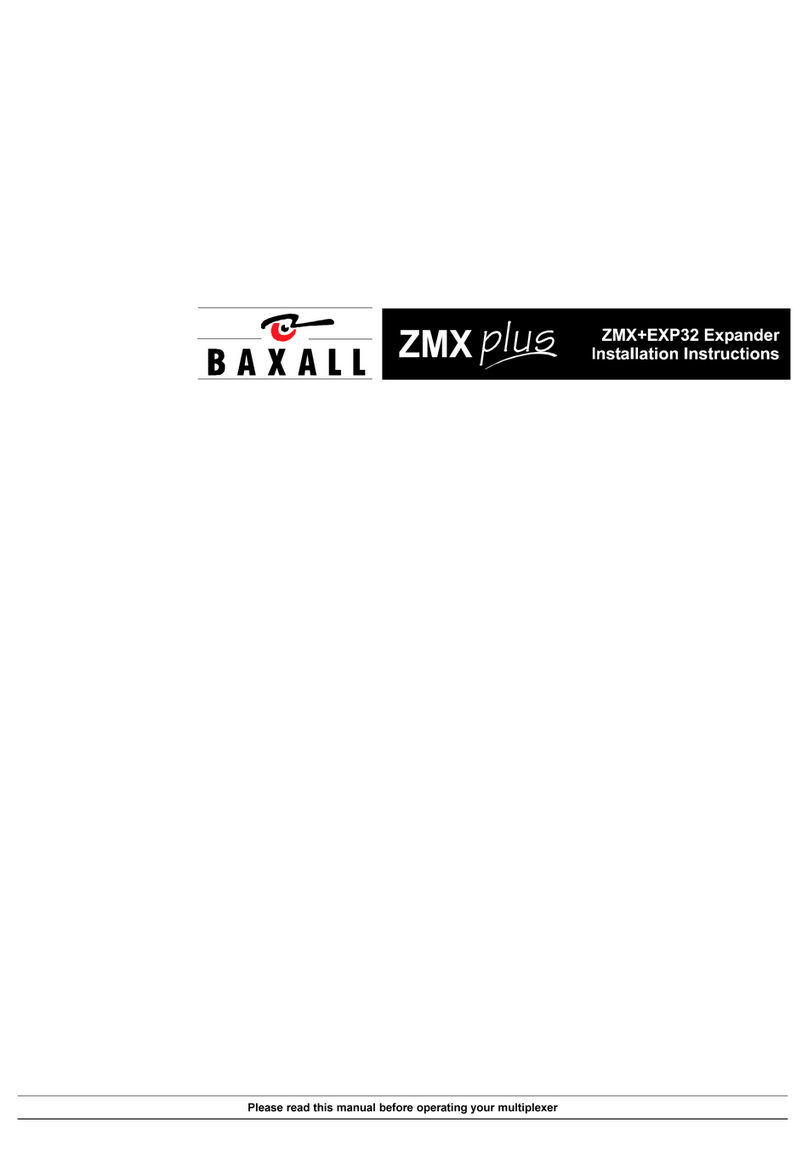
Baxall
Baxall ZMX plus ZMX+EXP32 installation instructions
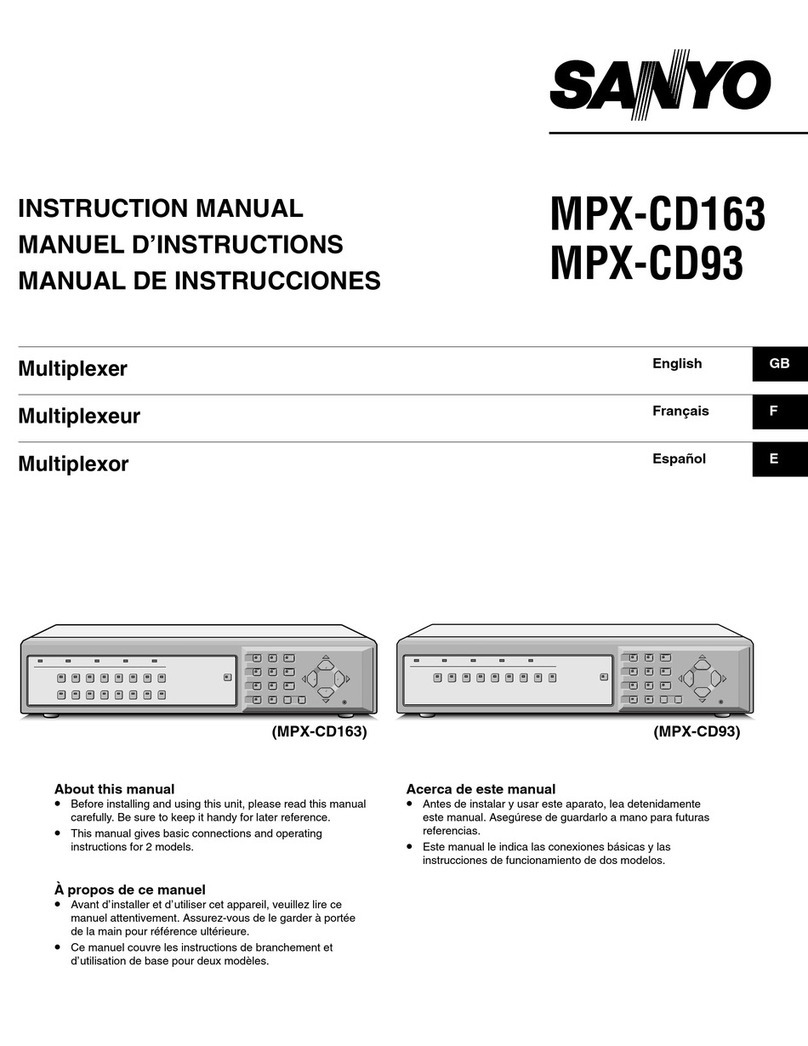
Sanyo
Sanyo MPX-CD163 instruction manual
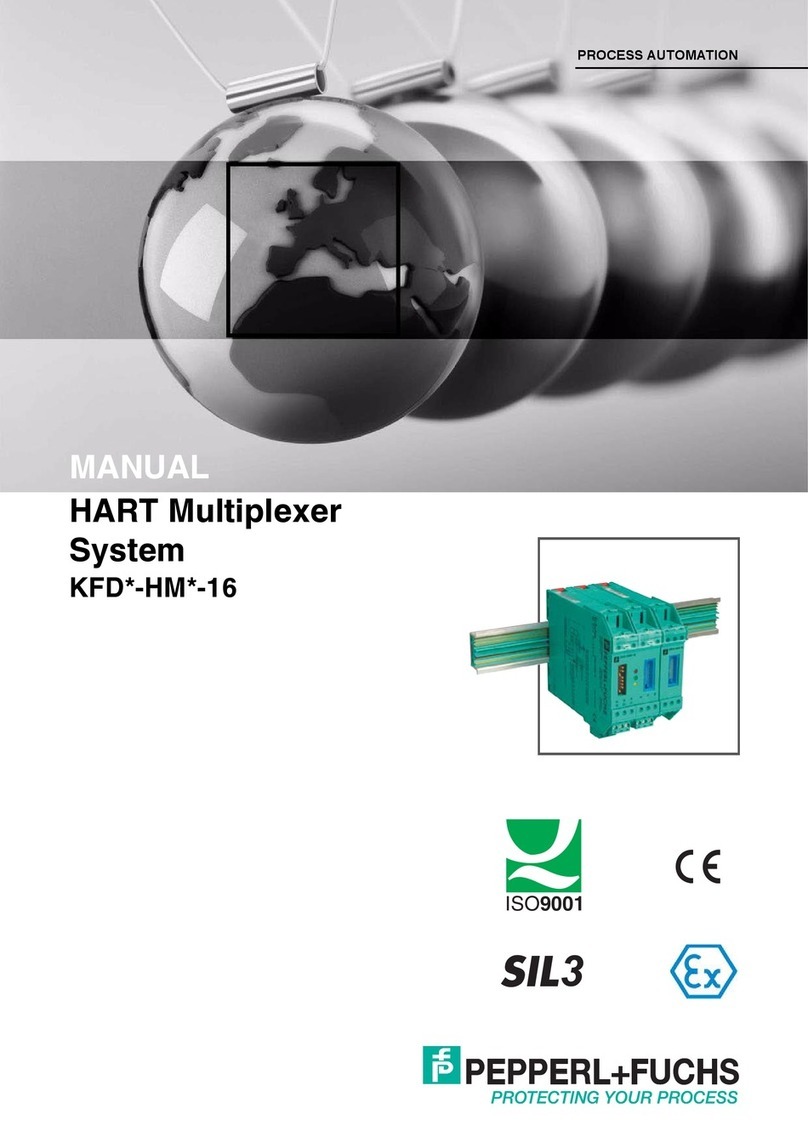
Pepperl+Fuchs
Pepperl+Fuchs KFD HM 16 Series manual
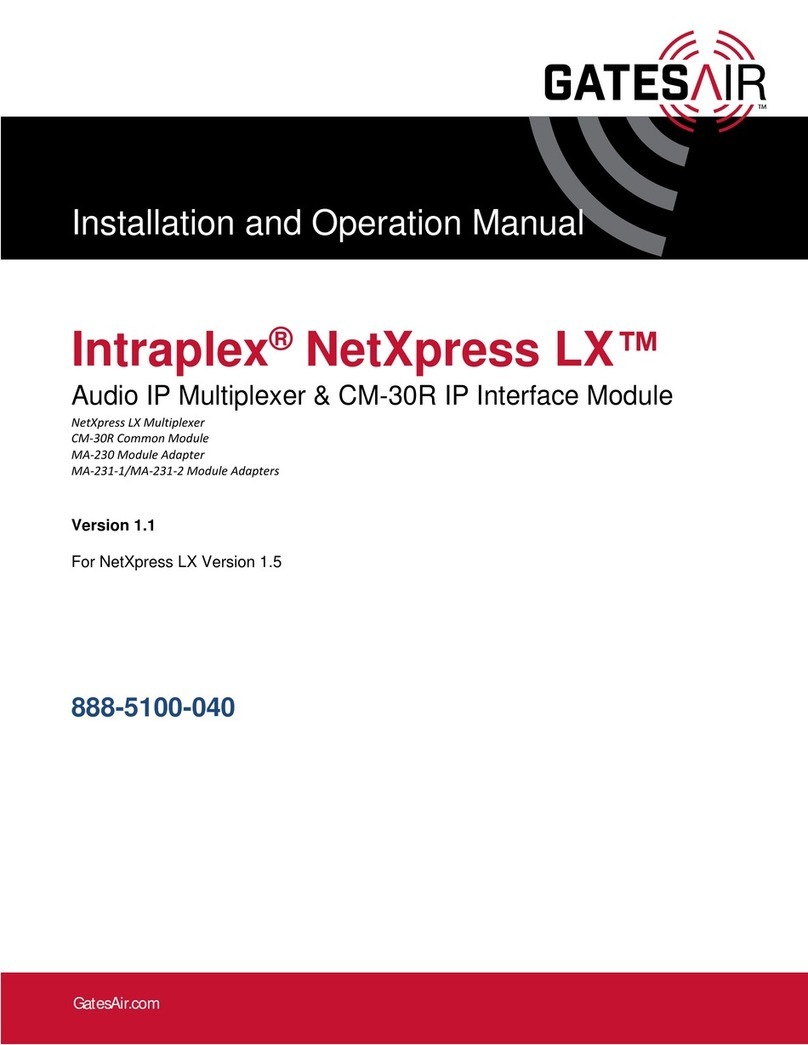
GatesAir
GatesAir Intraplex NetXpress LX Installation and operation manual
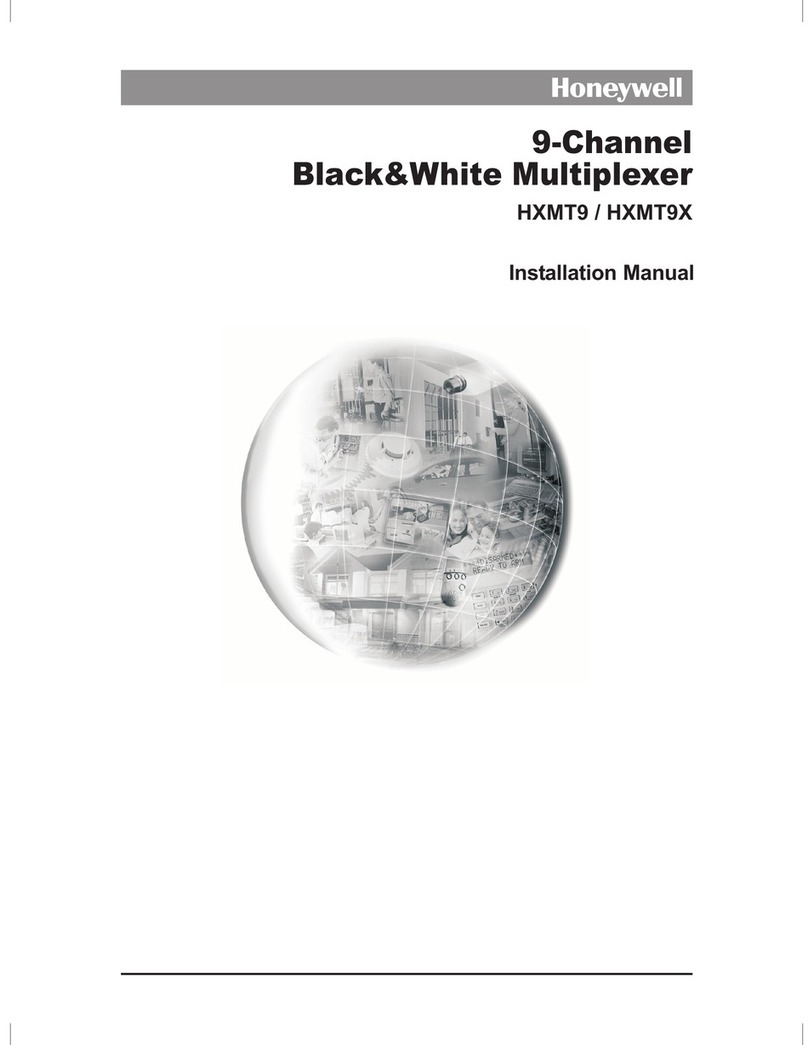
Honeywell
Honeywell HXMT9 / HXMT9X installation manual
